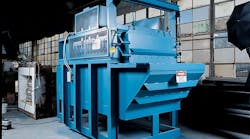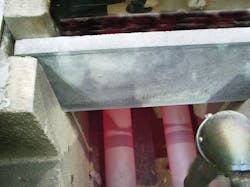Latest from Melt/Pour
When people hear of “green” technology they assume it refers to alternative energy sources, like solar, wind, water, and geothermal. Clean, electric energy is overlooked, including electricity used to melt aluminum. Following here is an examination of various electric melting and holding furnaces designs, and their efficiencies compared to fossil fuel fired units.
Electric reverb melting — For 40 years the electric radiant-roof reverb furnace has been many metalcasters’ first choice for low-cost production of clean, high-quality aluminum. A reliable, solid-state power control unit controls the electric version of the radiant-roof furnace and the temperature controller is a 1.4% accuracy, single-loop microprocessor with full proportioning features. This allows very close
temperature control, avoiding the widely fluctuating “on-off” system. The control panel is completely automatic and comes with a set of high-low alarm functions to ensure proper casting temperatures. If the furnace should overheat to a preset alarm level the panel will shut down. Also, “alarm-type” control thermocouples in these furnaces will sound an alarm if a thermocouple protection tube should leak.
1. Electric furnaces are offered with holding capacities from 1,200 to 20,000 lbs. These metal capacities allow for maximum drawdown prior to recharging.
2. The furnace is capable of “melting back down” if a metal freeze-up occurs due to extended power failure. The time frame of the re-melt depends on metal temperature and holding capacity. Keep in mind it is not a good furnace practice to allow the metal to freeze.
3. The most common dip well sizes range from 12x12 in. up to 24x24 in. Exposed well surface losses will run at 7400 BTUs per square feet per hour at 1,250° F metal temperature, therefore the sizing of the dip well should always follow careful consideration. Most customers prefer an "in-line" configuration with the charge well on one end and the hot metal dip-out well on the other end.
4. Energy consumption is very low in a gas-fired furnace. For example, a 2,000-lb capacity holder at 1,250° F will use approximately 25 BTUs/lb/hr to hold, with the well covers in place. An electric, low-energy holder under the same conditions has a rate of 0.00205 kW/lb
Electric versus gas — Silicon-carbide resistance elements transfer radiant heat to the workload to melt with only 0.23-0.25 kW/lb. And, metal melt loss is less than 1% when charged evenly. That fact alone promotes a relatively short payback on this electric melter. From a standpoint of furnace efficiency, electric furnaces are about 67% efficient. Gas-fired furnaces are at best 37% efficient, unless they are fitted with heat exchangers or regenerative burners. Consider:
• A 600-lb/hr furnace operating 20 hours per day and 340 days/year will melt 4,080,000 lb of aluminum per year.
• A typical gas-fired furnace will achieve approximately 3% in metal melt loss.
• 3% of 4,080,000 lb is 122,400 lb of metal melt loss.
• A typical electric furnace loses approximately 1% in metal melt loss.
• 1% of 4,080,000lb is 40,800lb of metal melt loss.
• Compared to gas-fired melting, electric reverb melting will save over 81,600 lb/year, which at $1.20/lb equals $97,920.00 saved per year.
Depending upon your costs for electricity and natural gas, your energy costs will be $51,612.00 (using 0.055 cents per kW) for electric melting; or $33,560.00 (using $5.50/1,000 cu.ft.) for gas-fired melting, and spend an additional $17,950.00 to melt with electricity1. Add up the savings, subtract the extra costs, and the difference is still less than a year of payback.
Holding costs — If a furnace holds about 5,200lb with well covers in place (using 30-38 BTUs/lb/hr) that will average 35 BTUs/lb/hr for a gas fired melter* (182,600 BTUs/hr) during idle times to hold temperature and .005968 kW/lb/hr in the electric melter2 (31.035 kW/hr) @ 1,250°F. These numbers are built into the melting numbers since you do not melt the entire 60 minutes of an hour.
While these numbers are theoretical they represent a conservative forecast of what may be achieved with proper charging practices and cleaning procedures. Other advantages of electric reverb furnace melting include: No need to obtain a permit for the flue, and less heat in the building; quiet operation; very high quality metal; no need to transport molten metal; and less make-up air is required in the plant. In addition, emissions are reduced from 148.41lb/hr C02 to 0; 118.14lb/hr of H20 to 0; and 708.294lb/hr of NOx to 0.
There are disadvantages, too: Electric reverbs do not have very good recovery rates, so if production volumes increase the electric melter may not keep up the pace. Also, charge rates must be maintained evenly or the vessel will lose temperature, and have a hard time recovering the loss. Electric furnaces develop oxide, just as gas-fired furnaces do, and electric reverbs usually hold about nine times the melting volume.
For diecasting operations with a series of machines (all on the same level, processing a common alloy), electric launders provide some benefits with clean energy. They can hold metal at 1,250° F for less than 1 kW/ft of launder. They perform a quiet transfer of the aluminum, which promotes metal quality and reduces melt loss. You may lose up to 0.5% of metal in the dross by pouring metal into holding furnaces. Remember: the aluminum must go through three turbulent transfers if you do not use a launder: from the melter to the transfer ladle (tap out or pump); pouring into a holding furnace; and ladling into the shot sleeve. Turbulent transfers cause oxides and inclusions in the metal that affect scrap rates considerably.
Electric Immersion Melting and Holding Furnaces
The latest option in electric melting is the immersion element furnace. They originated in Japan over 15 years ago but became popular in the U.S. about 10 years ago. There have been numerous improvements to the original design. By using a dense, castable hot face and a micro-porous silica, back-up super-insulated lining you can achieve excellent energy efficiency from these furnaces, for example, with metal at 1,250°F, casting temperatures are as low as 105°F.
The new, electric immersion-element holding furnace uses elements within sialon tubes in the middle of the aluminum bath. This produces no thermal head temperatures, which means less metal loss, less oxide growth, less dross, excellent bath temperature uniformity, and a casing temperature of less than 110° F. In addition, the furnace will hold aluminum at temperature (1,250° F) for less than 18 BTUs/lb, with well covers on, and less than 22 BTUs/lb in production. This compares to 35-40 BTUs/lb in a conventional radiant-roof electric holding furnace.
On average, they achieve two years of service life on the elements and over five years of service life for the tubes. You can change the elements on the fly and can stay hot with one element untill the other one gets changed. The 2,000-lb units have 25 kW connected, 4,400-lb units have 35 kW connected, and the 9,000-lb units have 90 kW connected. All of our immersion element furnaces have additional power connected in case you need a passing gear. Because these units have full proportional controls you use only what you need to maintain temperature, saving more energy than “on-off” designs.
Future is solar — The latest green tehcnology for melting aluminum is solar. A solar melting furnace is an “in-cell” melter with either immersion elements or radiant elements that will allow you to use the sun to melt about 185-200 lb/hr for small diecasting machines melting aluminum or zinc. However you must connect to plant electicity during the night and on very cloudy days, and you must have about 400 sq.ft of roof or field in which to place the solar panels.
If you want to provide “green technology” for your plant and community, look at electric melters and holders to reduce emmissions, fossil fuel purchases, and EPA permits — and look forward (possibly) to getting off of the EPA’s radar! More certain benefits will be a cooler plant and the cleanest metal in the business. Add a small solar melter to save more eneregy and earn bragging rights for having one of the most environmentally friendly companies in the world.
David W. White is the national sales manager for The Schaefer Group Inc. Contact him at [email protected], or visit www.theschaefergroup.com










